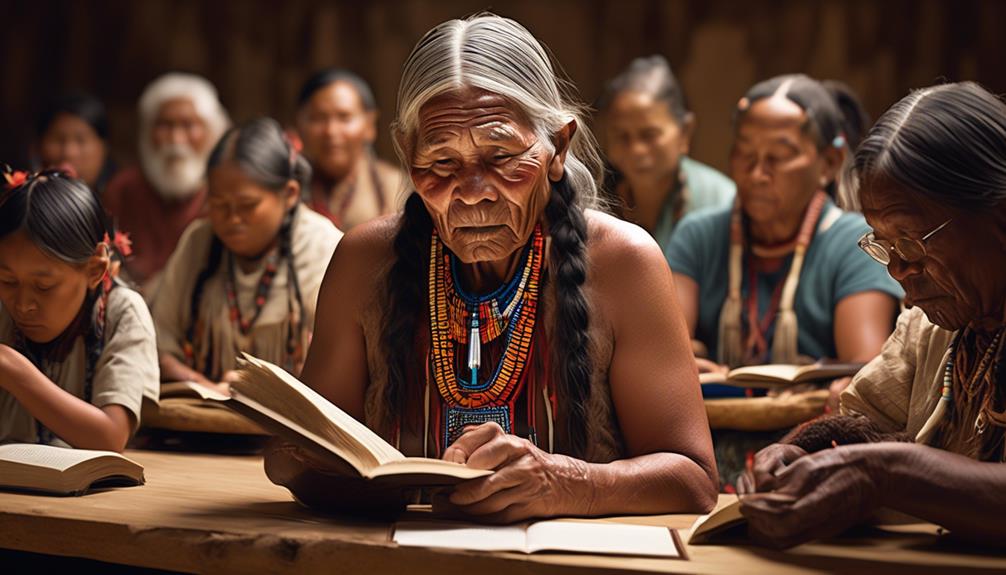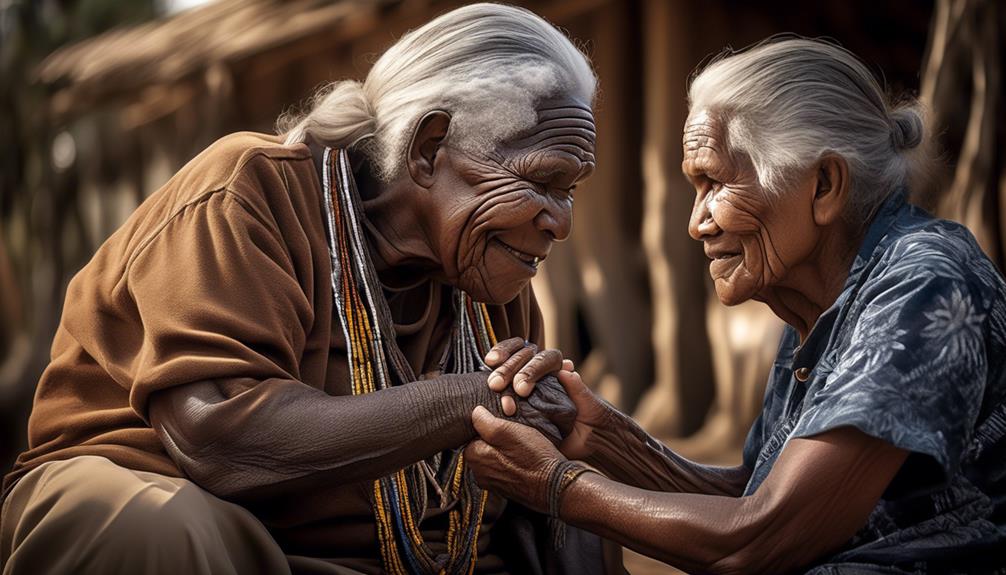Have you ever thought about the complexities of incorporating Indigenous languages into your everyday discussions? This topic requires thoughtful consideration and understanding of the cultural and historical significance that these languages hold.
As you navigate this conversation, there are important ethical and legal aspects to take into account, as well as opportunities to actively support language preservation efforts.
But where do you begin, and how can you ensure that your engagement with Aboriginal languages is respectful and beneficial? This discussion will provide insight into these questions and offer guidance for those seeking to engage with Aboriginal languages in a meaningful and respectful manner.
Key Takeaways
- Approach cultural appropriation with respect and consideration
- Seek permission and guidance from the Aboriginal community before using their language
- Understand the deep-rooted meanings and connections within Aboriginal languages
- Foster mutually respectful relationships with Aboriginal communities to support language revitalization and preservation efforts
Cultural Appropriation and Respectful Usage
When using Aboriginal languages, it's important to approach cultural appropriation with respect and consideration for the significance of these languages to the community. Respecting boundaries and cultural sensitivity are paramount when engaging with Aboriginal languages. It's essential to recognize that these languages aren't simply a means of communication, but they carry the history, stories, and traditions of the Aboriginal communities. Therefore, using these languages without proper understanding and respect can perpetuate the historical injustices that these communities have faced.
Understanding the cultural context and the significance of the language is crucial. It isn't just about the words themselves, but the deep-rooted meanings and connections they hold within the community. When engaging with Aboriginal languages, it's important to seek permission and guidance from the community. This demonstrates respect for their cultural heritage and acknowledges their authority over their language.
Comparatively, respecting boundaries when using Aboriginal languages aligns with the broader principles of cultural sensitivity. It involves being mindful of the historical and cultural context, and approaching the language with humility and a willingness to learn. Ultimately, it's about fostering mutually respectful relationships with the Aboriginal communities, which should be the guiding principle when using their languages.
Legal and Ethical Considerations

Understanding the legal and ethical considerations surrounding the use of Aboriginal languages is essential for fostering respectful and responsible engagement with these linguistic traditions.
Ethical implications play a significant role in the use of Aboriginal languages, as they're often tied to cultural and spiritual significance for Indigenous communities. It's crucial to consider the potential impact of language use on these communities and to approach language usage with respect and sensitivity.
Legal guidelines also come into play, as there may be specific laws or regulations governing the use of Aboriginal languages, especially in official capacities such as education, media, or public signage. These legal considerations aim to protect the rights of Indigenous peoples and ensure that their linguistic heritage isn't exploited or misrepresented.
Comparatively, ethical implications are more concerned with the moral and cultural aspects of language use, while legal guidelines focus on the regulatory and statutory frameworks. However, both must be carefully navigated to ensure that the use of Aboriginal languages is done in a manner that upholds the dignity and rights of Indigenous communities.
Understanding Language Revitalization Efforts
Language revitalization efforts are essential for preserving and promoting the rich linguistic heritage of Aboriginal communities. Understanding the complexities of language revitalization and the strategies employed is crucial for effective community engagement. Below is a table highlighting key approaches to language revitalization and their impact on community engagement.
| Language Revitalization Approach | Description | Impact on Community Engagement |
|---|---|---|
| Immersion Programs | Involves a full cultural and linguistic immersion experience, often in educational settings. | Fosters intergenerational transmission of language and cultural knowledge. |
| Community Language Classes | Regular classes open to community members of all ages, focusing on language instruction and cultural teachings. | Encourages community participation and shared learning experiences. |
| Digital Resources | Creation of digital tools such as apps, online courses, and multimedia content for language learning. | Increases accessibility and interest in learning the language, especially among younger generations. |
Ways to Support Indigenous Language Preservation

To further advance the preservation of Indigenous languages, exploring practical methods and support systems becomes paramount in sustaining the ongoing language revitalization efforts within Aboriginal communities.
There are several ways to support Indigenous language preservation:
- Community Language Programs: Encouraging the establishment of language programs within Aboriginal communities can provide a platform for individuals to learn, practice, and pass on their traditional languages. These programs can include language classes, immersion schools, and cultural events centered around language revitalization efforts.
- Collaboration with Elders and Knowledge Keepers: Involving elders and knowledge keepers in language preservation efforts is crucial. Their linguistic expertise and cultural knowledge are invaluable resources for teaching and preserving Indigenous languages.
- Digital Resources and Technology: Embracing digital tools and resources for language preservation, such as language learning apps, online dictionaries, and audiovisual recordings, can significantly aid in making Indigenous languages more accessible and engaging for younger generations.
- Support for Language Documentation: Providing funding and resources for the documentation of Indigenous languages through linguistic research and recording of oral histories can contribute to the preservation and understanding of these languages for future generations.
Resources for Learning and Engaging
When seeking resources for learning and engaging with Indigenous languages, it's essential to explore a variety of digital tools and traditional methods that cater to diverse learning preferences and cultural contexts.
Language learning resources can include online courses, mobile apps, and interactive websites that offer lessons in Indigenous languages. These digital tools often provide flexibility and accessibility, allowing learners to study at their own pace and engage with the language through multimedia content.
Additionally, traditional methods such as attending language immersion programs, seeking guidance from fluent speakers, and participating in cultural events can provide invaluable opportunities for practical language application and community engagement.
Comparatively, digital tools offer the advantage of convenience and often feature interactive elements that enhance the learning experience. On the other hand, traditional methods provide immersive cultural experiences and direct interaction with native speakers, fostering a deeper understanding of the language within its cultural context.
Engaging with Indigenous communities is crucial for language learning, as it provides opportunities to practice language skills, gain cultural insights, and contribute to the preservation of Indigenous languages. Community engagement may involve participating in language revitalization initiatives, attending cultural workshops, and actively supporting Indigenous language events and activities.
Frequently Asked Questions
Can I Use Aboriginal Language for Commercial Purposes?
Using Aboriginal language for commercial purposes raises ethical concerns about cultural appropriation. Consider the impact on the community and the respectful use of language.
It's essential to seek permission and engage in meaningful collaboration with Aboriginal communities. Understanding the significance of language in their culture is crucial. Respect their linguistic heritage and consider the potential consequences of commercializing it.
Prioritize ethical and respectful language usage to honor their traditions.
Are There Any Specific Guidelines for Using Aboriginal Language in Artwork or Design?
When creating artwork or design, using Aboriginal language requires careful consideration. Using traditional symbols can be as delicate as handling fragile artifacts in a museum.
It's essential to approach this task with respect and understanding. Research the specific guidelines provided by Aboriginal communities to ensure that your designs are respectful and culturally appropriate.
Engaging with the community and seeking guidance can help create meaningful and authentic representations.
Is It Okay to Use Aboriginal Language in Naming Businesses or Products?
Using Aboriginal language in branding should be approached with cultural sensitivity. Cultural appropriation in business can be harmful if not done respectfully.
It's essential to understand the significance of the language and its cultural context before incorporating it into business names or products. Research the specific language and consult with Aboriginal communities to ensure that its use is appropriate and respectful.
Strive to create partnerships that honor and support the Indigenous culture.
Can Non-Indigenous People Teach Aboriginal Language?
You may encounter teaching restrictions and cultural appropriation concerns when non-indigenous people want to teach Aboriginal language. It's essential to understand the complexities and sensitivities surrounding this issue.
While some Indigenous communities may welcome non-Indigenous people to learn and teach their language, it's crucial to approach this with utmost respect and humility.
Always seek permission, guidance, and collaboration from the Indigenous communities and elders before embarking on such a journey.
Are There Any Restrictions on Using Aboriginal Language in Public Performances or Events?
When using Aboriginal language in public performances or events, it's crucial to consider cultural sensitivity and language preservation.
Legal implications and community consultation are also important factors to take into account. Being mindful of these aspects demonstrates respect for the language and the community it belongs to.
It's essential to approach the use of Aboriginal language with care and consideration, ensuring that it's done in a way that honors and respects its cultural significance.
Conclusion
So, can you use Aboriginal language?
It's a complex issue, but with respect and understanding, it's possible to support Indigenous language preservation.
Imagine a world where diverse languages thrive, where ancient words are spoken with pride and reverence.
By learning about cultural appropriation and supporting language revitalization efforts, you can be part of the movement to preserve and celebrate Indigenous languages.
Together, we can create a more inclusive and diverse linguistic landscape for future generations.
Talise is a talented writer and an expert in her field. Her unique perspective and insights enrich our content with depth and authenticity. With a wealth of knowledge and a strong connection to the subjects she writes about, Talise crafts engaging and informative articles that resonate with our readers. Her dedication to bringing Indigenous culture and wisdom to light is truly commendable.










